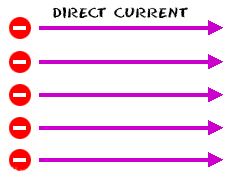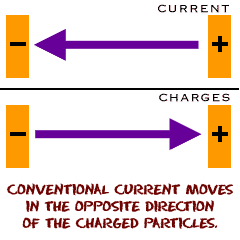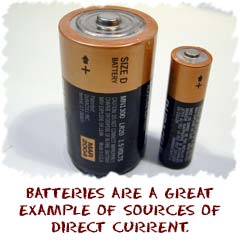A Direct Current
 There are two main types of current in our world. One is direct current (DC) which is a constant stream of charges in one direction. The other is alternating current (AC) that is a stream of charges that reverses direction. Let's look at DC power which was refined by Thomas Edison in the 1800s.
There are two main types of current in our world. One is direct current (DC) which is a constant stream of charges in one direction. The other is alternating current (AC) that is a stream of charges that reverses direction. Let's look at DC power which was refined by Thomas Edison in the 1800s.Moving in One Direction
The current in DC circuits is moving in a constant direction. The amount of current can change, but it will always flow from one point to another. Before we move on, we need to explain that physicists, as well as electricians, refer to something called conventional current.Do you remember that we talked about physicists agreeing to always use positive charges to determine how electric field lines would be drawn? Following through on that agreement, they also agreed to explain charge flow in terms of positive charges rather than electrons. So although electrons would flow from negative to positive, by convention (agreement), physicists refer to conventional current as a flow from high potential/voltage (positive) to low potential/voltage (negative). Reminding you that potential is like electrical height, this means that conventional current flows "downhill", which makes sense.
 Electrons move from areas where there are excess of negative charges to areas where there are a deficiency (or positive charge). Electrons move from "-" to "+", but conventional current is considered to move in the other direction. When you set up a circuit, conventional current is considered to move from the "+" to the "-" side.
Electrons move from areas where there are excess of negative charges to areas where there are a deficiency (or positive charge). Electrons move from "-" to "+", but conventional current is considered to move in the other direction. When you set up a circuit, conventional current is considered to move from the "+" to the "-" side.The idea about using positive charges in forming explanations comes from Benjamin Franklin. In Franklin's day, we didn't know about protons and electrons. Franklin believed that something moved through electrical wires, and he called these things "charge". He assumed there was only one kind of charge, and he logically assumed that charge would flow from a spot that had an excess (extra), to a spot that had a deficiency (too few). He called the spot with an excess "positive" and the spot with a deficiency "negative". So, for Franklin, charge flowed from positive to negative. We simply honor his achievements by continuing with this idea.
Battery Basics
 The best real-life example of direct current is a battery. Batteries have positive (+) and negative (-) terminals. If you take a wire and connect the positive and negative terminals on a battery, the electrons in the wires will begin to flow to produce a current. You can prove that the current is flowing if you connect a small light to the circuit. The light will begin to glow as the electrons pass through the filaments.
The best real-life example of direct current is a battery. Batteries have positive (+) and negative (-) terminals. If you take a wire and connect the positive and negative terminals on a battery, the electrons in the wires will begin to flow to produce a current. You can prove that the current is flowing if you connect a small light to the circuit. The light will begin to glow as the electrons pass through the filaments. DC power is used all over the world. You will probably use direct current power whenever you carry something around that uses electricity. Everything that uses batteries runs on DC power. Other countries use more portable power supplies because they might not have electric wiring in their houses.
That electric wiring in your house is AC power and it is completely different than DC. There are machines that can convert DC to AC power. Those machines might be used to take a DC battery in a boat and convert the power to AC so that a refrigerator can use it.